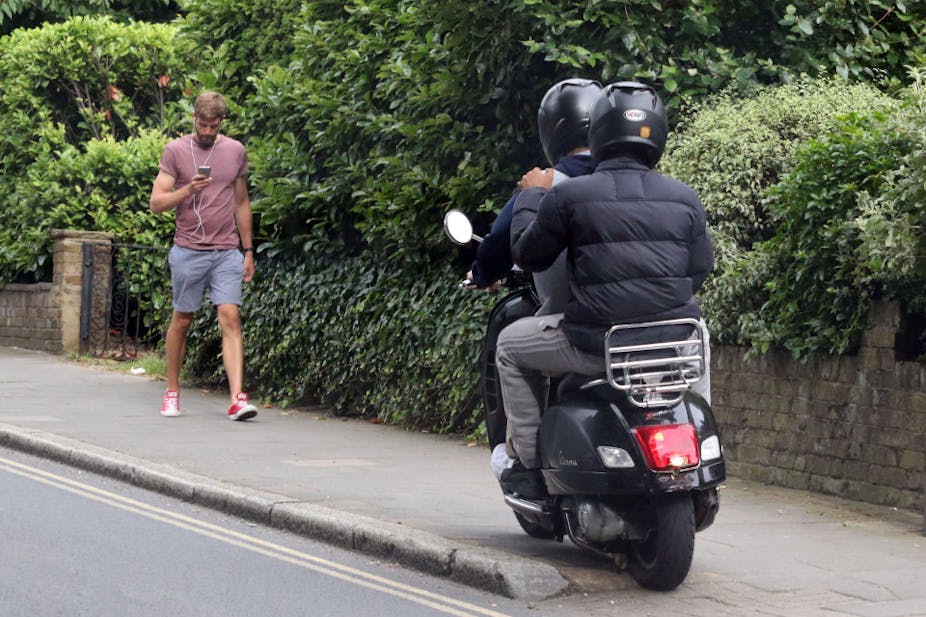The city of London has experienced a staggering rise in moped-related crimes. The metropolitan police recorded 1,053 moped-linked offences in 2014 which rose to 4,647 in 2015. In the year from June 2016 to 2017, they recorded 16,158. The crimes range from snatching mobile phones to acid attacks – many of which were committed by offenders on stolen motorbikes and scooters.
Now, the Metropolitan Police commissioner, Cressida Dick, has unveiled new tactics to catch the perpetrators. Police have been equipped with remote stingers, which puncture vehicle tyres, and DNA sprays, which help to identify offenders. Four specialised scrambler bikes will also make it easier for police to pursue mopeds down alleyways and back streets.

The commissioner suggested that these measures were already making a difference, citing a 24% fall in the number of moped offences since July. But it may be premature to claim victory in the fight against two-wheeled crime. Though police have had notable success prosecuting prolific offenders, more young men could take their places – and investment in new gadgets will do little to stem the tide.
“Forewarned is forearmed”, they say, so here are five things it’s important to know about London’s moped crime wave, based on my own research into crime and punishment in Britain.
1: The true causes are complicated
Crime in all its forms is driven by complex factors – including market forces such as supply and demand. There is a growing market for stolen mobile phones and mopeds, and a great deal of low-level crime trade now also takes place online.
While the industry did much to stop the theft of phone handsets a few years ago, demand for parts such as screens and batteries has made phones worth stealing again. What’s more, scooters and mopeds often have woefully bad security, making them easy pickings for determined offenders.
There is also a whole range of social and economic changes which affect the number of people involved in crime more generally. The national crime rise is not just linked to one type of offence – it is connected with the difficult and precarious position which many young men now occupy on the margins of society.
2: Delivery drivers are the first victims
Mopeds are an easy way for robbers to mount the kerb and snatch phones or bags from unsuspecting pedestrians – there was even an attempt made on the former chancellor of the exchequer, George Osborne, outside a BBC studio in London. But amid such reports, it’s easy to forget that low-wage workers in precarious employment, such as delivery riders and couriers, are often the first victims of this crime.
Not only do these workers face low pay and zero-hours contracts, their work is risky and their scooters present a target for thieves. Much of the crime involving scramblers, bikes and mopeds makes use of stolen vehicles. Delivery riders also carry small amounts of cash, which also makes them a target for robbery.

In July 2017, drivers for Deliveroo and UberEats gathered outside parliament, calling for government protection from violent robberies and attacks.
3: What police can (and can’t) do in pursuit
Some people blame the massive hike in moped crimes on criminals exploiting police “health and safety” rules, which determine what officers can and can’t do in a pursuit. Much of this commentary is ill-informed.
Guidelines set out by the College of Policing stipulate that pursuit should only be carried out by specially trained drivers in cases where “it is in the public interest to protect life, prevent or detect crime, or to apprehend an offender”.

There have been stories of criminals removing helmets in the belief that police will not pursue them. The reality is, police have always been constrained when pursuing offenders – their first duty is to public safety. Both police guidelines and common sense dictate that pursuing scooters or motorbikes – which can easily mount the pavement – presents more of a risk to public safety, and to offenders themselves, than chasing cars.
While police may find this frustrating, catching criminals is not often a matter of coming across them in the act and chasing them down. It usually requires methodical and time-consuming investigatory work. And in an era of austerity, that is not always happening. Unless the force is provided with the funding and resources it needs to run thorough investigations, a “crackdown” on moped crime probably won’t yield results in the long term.
4: It’s not just a London thing
Moped crime is regarded by some as a distinctly “London” issue. This is not strictly true. Rather, the way scooters are being used in London for for theft and mugging is distinct. In other parts of the country, there has also been a great deal of antisocial behaviour linked with quad bikes, scooters and mopeds.
In the West Midlands, there have been chaotic mass ride-outs, while in Merseyside and Greater Manchester, police teams have been set up to combat the illegal use of off-road “scrambler” motorbikes, often linked to antisocial behaviour and the distribution of drugs. It may be that other cities will see their own versions of the moped crime currently blighting London.
5: It may well get worse
Crime can shift and change quickly – and serious offences may become more common, while phone thefts drop. In October, the public were asked to help identify a moped gang that used bricks to smash their way into a designer shop in Chelsea, making off with a number of expensive handbags.
Criminals often gravitate to lower numbers of more serious offences over time: a classic example came from the North East and Midlands in the 1990s, when prolific car thieves began ram-raiding shops and stores, using stolen high-performance cars.
The causes of the rise and fall in crime levels are complex and difficult to predict. So it might just be a bit too early to celebrate a victory in the fight against moped crime.

